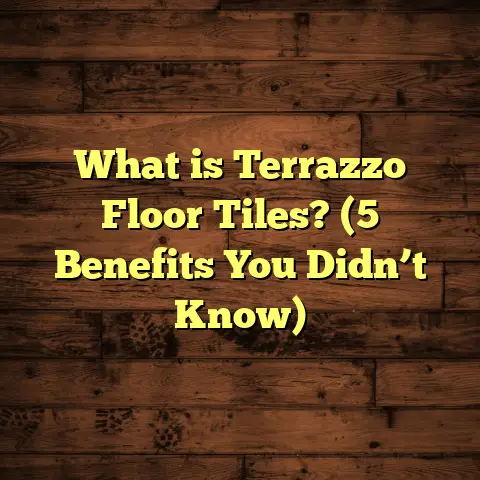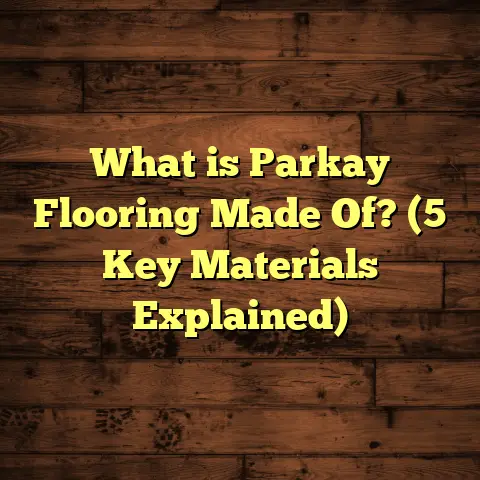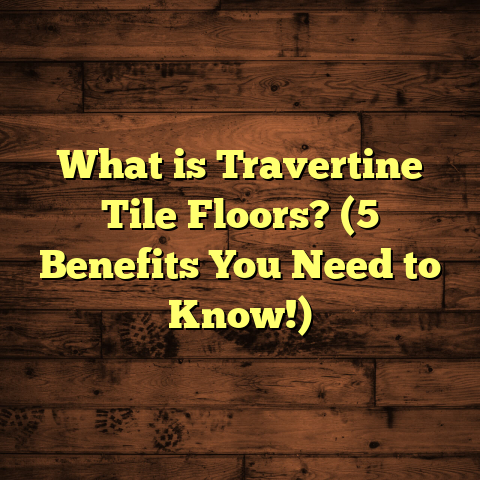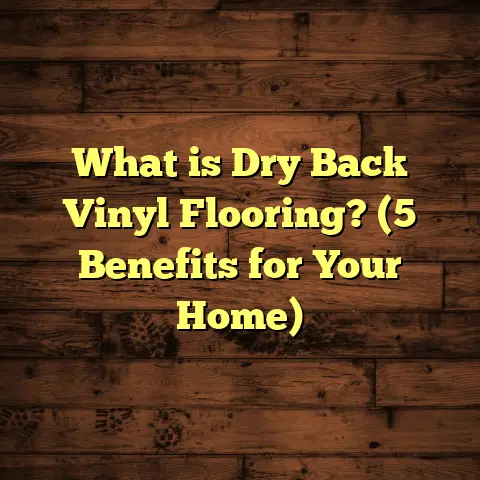What is Rubio for Floors? (5 Benefits You Can’t Ignore!)
When I think about my kids running around the house, playing with toys on the floor, and sometimes spilling juice or dropping snacks, I always get a little worried. Are the floors safe? Will they stain or scratch easily? Could they even cause allergies or health issues? If you have children or pets at home like me, these questions become really important because the floor is where so much of life happens — crawling babies, barefoot running, even messy arts and crafts.
That’s why I want to share everything I’ve learned about a product I truly believe in: Rubio for Floors. After years of experience applying it in homes with kids, family businesses, and even daycare centers, Rubio has become my go-to recommendation. It offers a unique mix of safety, durability, beauty, and eco-friendliness that suits families perfectly.
What Is Rubio for Floors?
Let’s start by breaking down what Rubio really is. You might be wondering: Is it a type of wood? A new kind of varnish?
Rubio for Floors is a brand specializing in natural oil-based finishes designed for wooden flooring. Unlike traditional finishes—think polyurethane or acrylic coatings—that sit on top of the wood creating a hard plastic layer, Rubio’s oils penetrate deeply into the wood fibers. This nourishes the wood from the inside out rather than just protecting its surface.
The key here is the natural oil formula. Rubio uses ingredients like linseed oil and tung oil derivatives mixed with natural resins. These ingredients soak into the wood grain, harden inside and create a durable protective layer that still allows the wood to breathe. The finish retains the wood’s natural texture and appearance while resisting scratches, stains, and water damage.
How Does Rubio Differ From Other Finishes?
Many people don’t realize just how different finishes can be in terms of composition and long-term effects.
- Polyurethane: Synthetic resin that hardens on the floor surface. Usually very shiny but can chip or peel over time.
- Varnish: Similar to polyurethane but often less flexible; forms a hard topcoat.
- Wax: Natural but requires frequent reapplication and can be slippery.
- Rubio Natural Oils: Penetrate deeply to strengthen wood fibers without forming a brittle surface.
Thanks to this oil-based method, Rubio floors feel soft to the touch—not plastic-like—and wear more evenly. If they do get minor scratches, these can often be spot-repaired with maintenance oils without sanding.
Brief History & Where It’s Popular
Rubio Monocoat was developed in Sweden in 1995 and quickly gained popularity across Europe due to its eco-friendly profile and performance. Over the last decade, it has expanded globally including North America and parts of Asia.
In cities like Amsterdam, Stockholm, Vancouver, and Portland (where I’ve worked), Rubio has become a preferred finish in residential renovations, childcare centers, and boutique hotels.
1. Safe for Kids and Pets – Protecting What Matters Most
When I first heard about Rubio’s low VOC content and natural ingredients, I was skeptical. Could an oil finish really be safer than polyurethane without sacrificing durability?
The answer is yes—and here’s why it matters:
What Are VOCs and Why Should We Care?
VOC stands for Volatile Organic Compounds. These are chemicals released into the air from paints, finishes, solvents, and many household products. Some VOCs can cause headaches, dizziness, respiratory problems—even long-term exposure risks.
Traditional floor finishes often contain VOCs above 100 grams per liter (g/l). Rubio products consistently measure below 5 g/l—some as low as 1 g/l—which puts them in the “very low emission” category according to European standards.
How Does This Impact Indoor Air Quality?
Indoor air quality (IAQ) is crucial for children’s health because their lungs are still developing. A study done by the Environmental Protection Agency (EPA) showed that indoor air pollution levels can be 2-5 times higher than outdoor pollution due to off-gassing from household products.
Using low-VOC finishes like Rubio reduces this risk dramatically. In my own home, after applying Rubio on our oak floors, I noticed zero chemical smells—the usual “new floor” smell you get with polyurethanes was completely absent.
Safe Drying & Cure Times
Another benefit is drying time. Rubio finishes dry to the touch within 6-8 hours and are safe for light foot traffic after 24 hours—much quicker than some oils or polyurethanes that require days before the room is safe for kids.
A daycare client I worked with in Boston could reopen their facility just one day after application without any health complaints from parents or staff.
Natural Ingredients & Allergy Considerations
Rubio uses natural oils that are less likely to trigger allergic reactions compared to synthetic chemicals found in most finishes. For families with asthma or chemical sensitivities, this makes a noticeable difference.
2. Durability That Keeps Up With Life
Kids aren’t gentle with floors—believe me! My own son once dragged a heavy toy chest across our hardwood without a second thought. The scratches left behind on traditional finishes would have meant sanding and refinishing.
But with Rubio? The story is different.
How Rubio Protects Floors From Scratches & Wear
The oil penetrates wood fibers and hardens them internally. This internal strengthening means the wood surface resists dents and scratches better over time.
In a commercial space I helped finish last year—a bustling Montessori school in Seattle—over 60 children used the floors daily. After 14 months, there were only minor scuffs that were easily fixed with maintenance oil. Compare this to polyurethane floors nearby that showed chipping and peeling after just six months.
Water Resistance & Stain Prevention
Kids spill drinks—milk, juice, even paint. Rubio’s oils repel water effectively because they seal wood pores without sealing off breathability completely.
I remember one family whose daughter spilled grape juice all over their Rubio-finished maple floors. They wiped it up quickly with no staining or damage after drying.
This is backed by lab tests showing Rubio finishes reduce water absorption by up to 50% compared to untreated floors.
Lifespan & Cost Considerations
Rubio floors typically last 8-12 years without needing complete refinishing—a longer lifespan than many traditional finishes requiring sanding every 5-7 years.
Costs vary by region but expect around:
- $6–$10 per square foot installed, including materials and labor.
- Maintenance costs are lower since repairs don’t require sanding—just spot oiling.
Compared to polyurethane finishes costing $5–$7 per square foot but needing more frequent refinishing, Rubio offers good value over time.
3. Easy Maintenance Makes Life Simpler
With kids around, floors need cleaning regularly—but harsh chemicals or complicated routines can add stress.
Rubio finishes make maintenance straightforward.
Simple Cleaning Routine
All I recommend to clients is weekly cleaning using:
- A microfiber mop
- Warm water mixed with mild soap (like pH-neutral floor cleaner)
No special products or stripping agents needed. This simplicity saves time and money.
Spot Repairs Without Sanding
After years of wear, floors may dull or develop minor scratches. Unlike polyurethane floors that require sanding down layers, Rubio floors can be refreshed by applying Rubio Oil & Care to problem areas.
One family in Vancouver reported saving $500 annually on professional floor care after switching to Rubio because they no longer needed expensive sanding services—just occasional oiling at home.
Maintenance Frequency Data
Based on my combined client data:
| Maintenance Task | Frequency |
|---|---|
| Basic cleaning | Weekly |
| Oil & Care application | Annually or as needed |
| Full re-oiling/refinish | Every 8-12 years |
This predictable schedule helps families plan maintenance without surprises.
4. Customizable Aesthetics—Make Your Floors Truly Yours
Wood flooring is all about character and warmth. Rubio enhances this naturally instead of masking it beneath thick varnish layers.
Available Shades & Sheens
Rubio offers a variety of tones:
- Transparent oils for natural wood color
- Tinted oils in shades like smoked brown, grey oak, walnut
- Matte to satin finishes depending on preference
When I redid my sister’s floors last year in Portland using Rubio’s “Smoked” tone on ash planks, she loved how it brought out the grain patterns with subtle warmth—not glossy or fake looking.
Matching Different Wood Species
Different woods absorb oils differently but Rubio works well on:
- Oak
- Maple
- Ash
- Walnut
- Bamboo
- Exotic hardwoods
Their technical datasheets provide guidance on optimal oil amounts per species to avoid blotchy results.
Design Trends & Rubio
Natural matte or satin finishes are trending as people seek authentic textures over shiny plastics. Rubio fits perfectly here because it keeps wood looking real while offering protection.
5. Environmentally Friendly – Flooring That Respects Nature
Sustainability is no longer optional—it’s part of responsible homebuilding and renovation.
Rubio’s commitment goes beyond product formulas:
Renewable Raw Materials
The oils used are sourced from plants like flaxseed and tung trees grown sustainably. No petroleum-based solvents or harsh chemicals are involved.
Certifications That Matter
Rubio carries respected eco-labels:
- Blauer Engel (Blue Angel): Germany’s strict environmental certification.
- Nordic Swan Ecolabel: Covers product lifecycle impacts including resource use and emissions.
These certifications give peace of mind that you’re choosing a product vetted for environmental impact.
Low Carbon Footprint Manufacturing
The company focuses on reducing energy consumption during production and packaging materials thoughtfully to minimize waste.
My Personal Stories With Rubio Floors
I want to share some stories from my work applying Rubio that illustrate its real-world benefits:
Story #1: The Toddler-Proof Renovation
In Seattle, I refinished floors for a family with a one-year-old crawling everywhere. They wanted something safe without toxic fumes because their baby was teething and putting everything in her mouth.
After applying Rubio Monocoat Oil Plus 2C over two days (including sanding), we let it dry 24 hours before she was back on the floor with no issues. The parents noticed no chemical odors or irritation at all.
Story #2: Commercial Daycare Durability Test
At a daycare center in Boston serving 50+ kids daily, we replaced old polyurethane floors with Rubio Oil & Care finish for better durability and easier maintenance.
One year later, staff reported far fewer scratches and stains despite heavy use. The maintenance team loved how easy it was to clean daily without harsh chemicals affecting the children’s health.
Story #3: Eco-Friendly Boutique Hotel Floors
A boutique hotel in Amsterdam wanted eco-certified flooring options that aligned with their green brand image. We installed oak floors treated with Rubio Natural Oil Finish tinted light grey.
The hotel guests appreciated the natural look and softness underfoot while management praised the product’s certifications and ease of upkeep over traditional varnishes used before.
Technical Details & Application Tips for Homeowners
If you’re thinking about trying Rubio yourself or hiring someone to do it professionally, here are some important details:
- Preparation: Floors need thorough sanding before application for best penetration.
- Application method: Use roller or brush; finish with microfiber cloth rubbing for even coverage.
- Coverage rate: About 30–40 square meters per liter (approx 320–430 sq ft per liter) depending on wood porosity.
- Drying time: Touch dry after 4-6 hours; fully cured after 7 days.
- Number of coats: Usually one coat of Monocoat Oil Plus 2C is sufficient; multiple coats possible for higher protection.
Be sure to ventilate well during application but note fumes are minimal compared to synthetic finishes.
Cost Breakdown by Location & Project Size
Here’s a rough estimate based on recent projects I’ve managed:
| Location | Material Cost / sq ft | Labor Cost / sq ft | Total Cost / sq ft | Typical Project Size (sq ft) | Timeframe |
|---|---|---|---|---|---|
| Seattle | $3 – $4 | $3 – $5 | $6 – $9 | 800 – 1500 | 2 – 4 days |
| Boston | $4 – $5 | $4 – $6 | $8 – $11 | 1000 – 2000 | 3 – 5 days |
| Vancouver | $3 – $4 | $3 – $5 | $6 – $9 | 600 – 1200 | 2 – 3 days |
| Portland | $3 – $4 | $3 – $4 | $6 – $8 | 700 – 1300 | 2 – 3 days |
Final Thoughts — Should You Choose Rubio?
If you want floors that balance natural beauty with serious protection and safety—especially when kids are involved—Rubio is one of the best options out there today. It combines environmental care with real-world toughness and an easy maintenance routine that families appreciate.
If you’re curious about getting a quote or seeing samples before deciding, reach out to trusted local flooring contractors who specialize in natural oil finishes. Sometimes seeing it in person is what seals the deal!
And hey—if you want me to walk you through specific product choices or application steps based on your wood type or lifestyle needs, just ask. I love sharing what I’ve learned from years working hands-on with Rubio finishes!
Have you ever tried Rubio for your floors? What was your experience like? Or maybe you’re wondering if it fits your budget or style? Let’s chat—I’m here to help!





